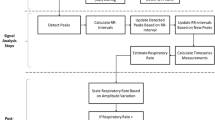Abstract
A method for deriving respiration from the pulse photoplethysmographic (PPG) signal is presented. This method is based on the pulse width variability (PWV), and it exploits the respiratory information present in the pulse wave velocity and dispersion. It allows to estimate respiration signal from only a pulse oximeter which is a cheap and comfortable sensor. Evaluation is performed over a database containing electrocardiogram (ECG), blood pressure (BP), PPG, and respiratory signals simultaneously recorded in 17 subjects during a tilt table test. Respiratory rate estimation error is computed obtaining of 1.27 ± 7.81 % (0.14 ± 14.78 mHz). For comparison purposes, we have also obtained a respiratory rate estimation from other known methods which involve ECG, BP, or also PPG signals. In addition, we have also combined respiratory information derived from different methods which involve only PPG signal, obtaining a respiratory rate error of −0.17 ± 6.67 % (−2.16 ± 12.69 mHz). The presented methods, PWV and combination of PPG derived respiration methods, avoid the need of ECG to derive respiration without degradation of the obtained estimates, so it is possible to have reliable respiration rate estimates from just the PPG signal.





Similar content being viewed by others
References
Bailón R, Sörnmo L, Laguna P (2006) ECG-derived respiratory frequency estimation. In: Clifford G, Azuaje F, McSharry P (eds) Advanced methods and tools for ECG data analysis. Artech House Inc., Boston, pp 215–244
Bailón R, Sörnmo L, Laguna P (2006) A robust method for ECG-based estimation of the respiratory frequency during stress testing. IEEE Trans Biomed Eng 53(7):1273–1285
Chua CP, Heneghan C (2005) Pulse transit time-derived respiratory parameters and their variability across sleep stages. Eng Med Biol Soc 27:6153–6156
Constant I, Laude D, Murat I, Elghozi J (1999) Pulse rate variability is not a surrogate for heart rate variability. Clin Sci 97(4):391–397
Dash S, Shelley KH, Silverman DG, Chon KH (2010) Estimation of respiratory rate from ECG, photoplethysmogram, and piezoelectric pulse transducer signals: a comparative study of time–frequency methods. IEEE Trans Biomed Eng 57(5):1099–1107
De Meersman RE, Zion AS, Teitelbaum S, Weir JP, Liberman J, Downey J (1996) Deriving respiration from pulse wave: a new signal-processing technique. Am J Physiol Heart Circ Physiol 270(5):H1672–H1675
Edenbrant L, Pahlm O (1988) Vectorcardiogram synthesized from a 12-lead ECG; superiority of the inverse dower matrix. J Electrocardiol 21(4):361–367
Felblinger J, Boesch C (1997) Amplitude demodulation of the electrocardiogram signal (ECG) for respiration monitoring and compensation during MR examinations. Magn Reson Med 38(1):129–136
Gil E, Bailón R, Vergara JM, Laguna P (2010) PTT variability for discrimination of sleep apnea related decreases in the amplitude fluctuations of ppg signal in children. IEEE Trans Biomed Eng 57(5):1079–1088
Gil E, Orini M, Bailón R, Vergara J, Mainardi L, Laguna P (2010) Photoplethysmography pulse rate as a surrogate measurement of heart rate variability during non-stationary conditions. Physiol Meas 31:1271–1290
Gil E, Vergara JM, Laguna P (2008) Detection of decreases in the amplitude fluctuation of pulse photoplethysmography signal as indication of obstructive sleep apnea syndrome in children. Biomed Signal Process Control 3:267–277
Gravelyn TR, Weg JG (1980) Respiratory rate as an indicator of acute respiratory dysfunction. J Am Med Assoc 244(10):1123–1125
Hamilton PS (1996) A comparison of adaptive and nonadaptive filters for the reduction of powerline interference in the ecg. IEEE Trans Biomed Eng 43:105–109
James NW, Adams GM, Wilson AF (1989) Determination of anaerobic threshold by ventilatory frequency. Int J Sports Med 10(3):192–196
Johansson A, Oberg PA (1999) Estimation of respiratory volumes from the photoplethysmographic signal. Part I: experimental results. Med Biol Eng Comput 37:42–47
Laguna P, Jané R, Caminal P (1994) Automatic detection of wave boundaries in multilead ECG signals: validation with the CSE database. Comput Biomed Res 27:45–60
Lazaro J, Gil E, Bailón R, Laguna P (2011) Deriving respiration from the pulse photoplethysmographic signal. In: Computing in cardiology 2011. IEEE Computer Society Press, pp 713–716
Martinez JP, Almeida R, Olmos S, Rocha AP, Laguna P (2004) A wavelet-based ECG delineator: evaluation on standard databases. IEEE Trans Biomed Eng 51(4):570–581
Moody GB, Mark RG, Zoccula A, Mantero S (1986) Derivation of respiratory signals from multi-lead ECGs. In: Computers in cardiology 1985, IEEE Computer Society Press, pp 113–116
Travaglini A, Lamberti C, DeBie J, Ferri M (1999) Respiratory signal derived from eight-lead ECG. In: Computers in cardiology 1997, IEEE Computer Society Press, pp 65–68
Yang B, Chon K (2010) A novel approach to monitor nonstationary dynamics in physiological signals: application to blood pressure, pulse oximeter, and respiratory data. Ann Biomed Eng 38(11):3478–3488
Zhao L, Reisman S, Findly T (1994) Derivation of respiration from electrocardiogram during heart rate variability studies. In: Computers in cardiology 1993, IEEE Computer Society Press, pp 53–56
Acknowledgments
This work is supported by Universidad de Zaragoza under fellowship PTAUZ-2011-TEC-A-003, Ministerio de Ciencia y Tecnología, Spain, FEDER; under project TEC2010-21703-C03-02, by CIBER-BBN through Instituto de Salud Carlos III, by ARAID and Ibercaja under Programa de APOYO A LA I+D+i and by Grupo Consolidado GTC from DGA.
Author information
Authors and Affiliations
Corresponding author
Rights and permissions
About this article
Cite this article
Lázaro, J., Gil, E., Bailón, R. et al. Deriving respiration from photoplethysmographic pulse width. Med Biol Eng Comput 51, 233–242 (2013). https://doi.org/10.1007/s11517-012-0954-0
Received:
Accepted:
Published:
Issue Date:
DOI: https://doi.org/10.1007/s11517-012-0954-0




